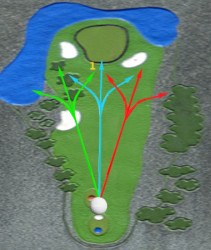
In golf, the term “banana ball” refers to a shot that curves severely from left to right (for right-handed golfers) or from right to left (for left-handed golfers). It is a descriptive term used to characterize a specific type of shot shape or ball flight pattern.
A banana ball is typically the result of a significant side spin imparted on the ball at impact. This side spin causes the ball to veer off its intended path and curve in the shape of a banana. The curvature is more pronounced compared to a standard fade or draw shot.
The banana ball is usually associated with a slice for right-handed golfers or a hook for left-handed golfers. A slice occurs when the ball curves excessively from left to right, while a hook curves sharply from right to left.
The banana ball is generally considered an undesirable shot shape because it can lead to loss of accuracy and distance. It is often the result of an improper swing path, open clubface at impact (for slices), or a closed clubface (for hooks).
Golfers typically aim to eliminate or minimize the banana ball by working on their swing mechanics, grip, and alignment. Improving swing path, clubface control, and balance can help reduce the amount of side spin and promote more consistent, straighter shots.
It's important to note that the term “banana ball” is colloquial and not an official golfing term recognized by governing bodies like the USGA or R&A. It is simply a descriptive term used by golfers to refer to a specific shot shape characterized by significant curvature.
Banana Ball, Golf Term:An extreme slice, usually a pull slice.





